There is nothing better than the taste of freshly blended basil pesto. It’s creamy, flavorful, and perfect to use in so many different ways. Say no to canned and yes to homemade pesto!
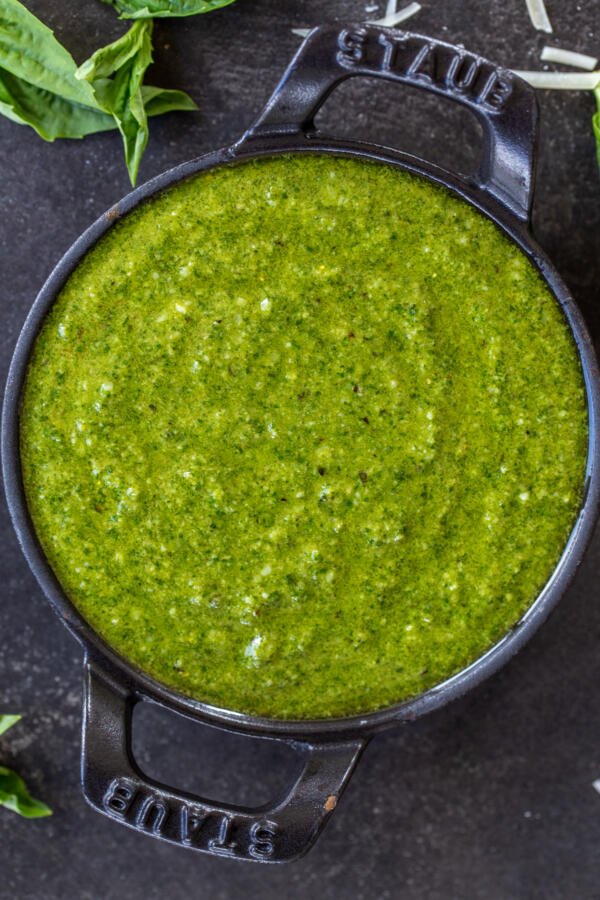
What is Pesto?
Pesto is a creamy green sauce that has a fresh and herby flavor. The primary ingredient in pesto is basil, which is blended together with other ingredients to make a smooth and rich sauce. Pesto is often used in pasta dishes, as a seasoning for chicken, or as a dip/spread over toasted bread.
Our homemade basil pesto is filled with vibrant flavor — better than any canned or grocery store versions we’ve tried so far. Plus, it comes together in a brief 10 minutes and is super easy to store to enjoy time and again.
Ingredients for Basil Pesto
Most people know what goes into popular sauces like marinara, but pesto may be a little more unfamiliar. There’s no need for mysteries here, so here’s a general overview of the ingredients that go into our basil pesto.
- Basil: The star of the show here is basil. For the best pesto, use only the leaves of fresh basil.
- Nuts: Pine nuts are the traditional choice in pesto, but walnuts can be used in a pinch.
- Cheese: Good quality parmesan is key (a block of parmesan versus pre-shredded is preferred)! Vary the amount of parmesan added to the pesto to your own liking.
- Oil: Quality extra virgin olive oil will make this pesto taste its best. To learn more about different types of oils, check out our oil guide.
- Seasoning: What’s any recipe without a little salt, black pepper, and garlic? Adjust these seasonings to your individual taste.
Flavor tip: If you like a hint of citrus flavor in your pesto, add two tablespoons of fresh lemon juice.
Basil Pesto Video
How to Make Basil Pesto
Make fresh pesto in less than 10 minutes with these easy steps! All you need is a food processor, silicone spatula, and mason jars to store the pesto in.
- Combine basil and nuts: Using a food processor, pulse the fresh basil leaves and the pine nuts.
- Add garlic and cheese: Add in garlic cloves and parmesan cheese and pulse. Scrape the sides of the food processor and pulse again.
- Blend with olive oil: With the food processor on low, pour in olive oil and blend until the mixture is creamy, scraping the sides as needed.
- Refrigerate: Season to taste and then refrigerate until ready to use!
Hot tip: Sometimes basil leaves taste bitter. If your pesto is bitter, add a little more salt, sugar, or lemon juice to counteract the bitterness of the basil.


Tips for Making Pesto
Pesto is loved for its freshness and versatility across many dishes. To make the most of your pesto, follow these tips.
- Wash the basil well: Wash the basil very well in cold water. Avoid washing in warm water as this will wilt the leaves and affect the taste.
- Dry the leaves: Use a salad spinner or dry the basil with a paper towel before blending.
- Add in parsley (optional): Add fresh parsley for a slightly lighter pesto. Decrease the amount of basil equal to the amount of parsley you use.
- Toast the nuts: For a toasted nutty flavor, toast the pine nuts or walnuts in a small pan over medium heat. Stir often until the nuts are fragrant.
- Substitute the cheese: If you are out of parmesan cheese, use any Italian-style hard and salty cheese like parmigiano-reggiano, asiago, or grana padano. Avoid softer cheeses like mozzarella or brie as they will not taste or mix in correctly.
Ways to Use Basil Pesto
Like many sauces, pesto is incredibly versatile and can be used in a variety of different ways. Here are a few ideas to help you enjoy your freshly made basil pesto.
- Seafood: Use pesto to add flavor to your baked salmon like in our baked pesto salmon recipe.
- Chicken: Season your chicken breast or chicken thighs with pesto like in our pesto chicken recipe, or serve it on top of or beside a cut of parmesan crusted chicken.
- Sandwich: Pesto sauce is a great spread to use in a wrap or sandwich like our turkey focaccia sandwich.
- Pasta: Toss the pesto in with a bowl of homemade pasta for a classic Italian spin, or make a pesto pasta salad.
- Pizza: Instead of using traditional marinara or pizza sauce, use pesto to make flatbread pizza. Yum!
- Galette: Top this savory tomato galette with dollops of pesto
Storing
This recipe makes about six servings, so chances are, you will have leftovers to store away for later. Here are the best methods to store your pesto so it stays fresh for longer!
- Freezer: To freeze for up to three months, freeze portions of pesto in an ice cube tray. Once frozen, transfer frozen cubes into a freezer bag. This allows you to easily thaw only as much pesto as you need.
- Refrigerator: To store for up to a week in the fridge, transfer pesto into an airtight container or a jar. Sometimes, pesto may turn brown if exposed to too much air. Drizzle a small layer of olive oil on top of the pesto to prevent air from entering and oxidizing it.
FAQ
Where did pesto originate?
Pesto is said to have originated in Genoa, located in northwestern Italy.
Are there different types of pesto?
There are a few different types of pesto including traditional pesto (made with basil), red pesto (made with the addition of sun-dried tomatoes or roasted peppers), and other “green” pesto (made with spinach, arugula, cilantro, or other green ingredients).
How do I mellow out the basil taste in pesto?
If the flavor of basil is too strong, pesto can be mellowed out by cutting down or substituting the amount of basil. Baby spinach leaves are a good substitute as they have that vibrant green color but do not have a strong taste like basil.
What nuts are used to make basil pesto?
Traditionally, pine nuts are used to make basil pesto. Other common nut substitutions include walnuts, almonds, and pistachios.
More Sauces to Love
- Homemade BBQ Sauce – Tangy and sweet BBQ sauce
- Teriyaki Sauce – Sweet, salty, and thick sauce for dressing up meat and veggies
- Adjika Recipe – A dip made of tomatoes, garlic and other veggies
- Chimichurri Sauce – Pesto-like sauce made from parsley and cilantro
- 5 Minute Peanut Sauce – Lettuce wraps or spring rolls aren’t complete without it
- Tzatziki Sauce – Greek dipping sauce made with yogurt
- Alfredo Sauce – White cheesy cream sauce that pairs with seafood, chicken and vegetables
Recipe
Ingredients
- 2 cups fresh basil leaves
- 1/3 cup pine nuts
- 2 large garlic cloves minced
- 1/3 cup Parmesan cheese
- 1/2 cup extra virgin olive oil
- 1/3 tsp salt adjust to taste
- 1/4 tsp ground black pepper adjust to taste
Instructions
- In a food processor, combine basil with pine nuts. Pulse 4 times.
- Add in garlic and cheese, then pulse 3 more times. Scrape the sides and pulse again.
- Turn the food processor on low and slowly pour in olive oil into the mixture. Blend until the mixture is creamy. You may need to stop a few times to scrape the sides.
- Season to taste. Refrigerate until ready to use.

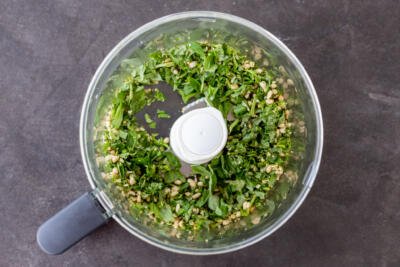

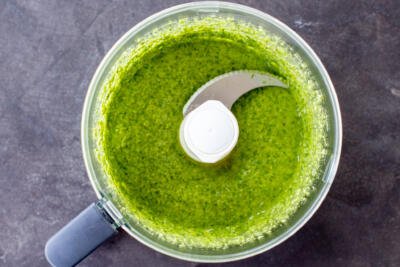
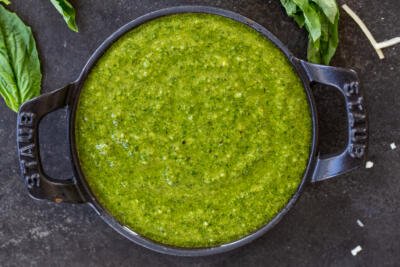
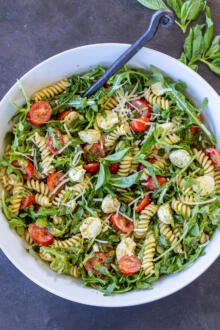
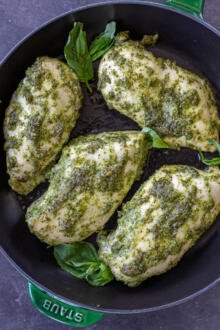



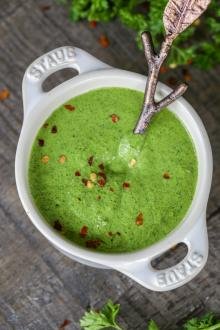
There is nothing better than fresh, basil pesto!! It smells & tastes so good! We love it for so many recipes!
Hi Kristyn, I completely agree! I love it so much more than store bought! Thank you for your feedback. Enjoy!
So easy! I will never buy it from the store again. So fresh and delicious!
Hi Jana, I am thrilled that this recipe was a success! Thank you for your feedback, enjoy!
Loved this basil pesto on our panini sandwiches! So delicious!!
Hi Jamie, I am thrilled that you loved this recipe. Sounds like it was so tasty! Thank you for your feedback, enjoy!